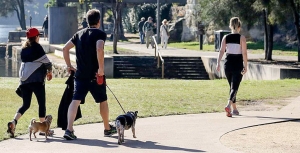Displaying items by tag: recreation needs study
Ku-ring-gai recreation needs study
Ku-ring-gai Council has recently completed a recreation needs study. The June meeting agreed to put the study out for public exhibition but it is not there yet.
The outcomes are important for putting the demands for the use of our natural areas into perspective.
Population
Ku-ring-gai’s population is growing and becoming more diverse. Current population is 124,000. Around 17,000 more people will live in the LGA by 2041 (Department of Planning population projections, 2022). In 2021, around 25% of residents live in apartments, 28% speak a language other than English at home, and families with children and young people make up 46% of households.
People want more spaces to participate in informal recreation for fun
Fun and enjoyment (90%), fitness and exercise (88%) and getting fresh air (88%) are the main reasons residents use recreation spaces. Walking (87%) is the most popular recreation activity followed by bushwalking (75%). Other popular activities include picnics (64%), relaxing (58%), walking the dog (48%), fitness activities (44%) and running (44%).
Sports are still in high demand, but non- traditional sports are emerging
Local sporting clubs and peak bodies indicated that participation in organised sport remains popular, reporting a 41% increase in participation in the past five years. There is also increasing demand for spaces for informal social team sports, emerging games such as Padel and pickleball, as well as demands for more spaces for women’s sports.
Sporting fields
A review of the facilities against benchmarks indicates that there are adequate sports fields but their quality should be improved. This is a major barrier for participation with the issues being lighting, amenities, maintenance, safety and unfit facilities for female participation.
There is an oversupply of tennis courts and a need for more basketball courts.
Analysis of council’s formal booking data shows that natural turf sports fields operate below capacity throughout the year, indicating the opportunity to improve their capacity and utilisation. However there are questions about whether the booking data is a true indication of actual usage. It can be observed that tennis courts get a lot of informal usage.
Sports fields and sports spaces can no longer be single purpose or single code to meet needs. The availability of suitable additional land is limited and expensive. This means planning for more diverse and equitable open spaces and recreation facilities that are designed for shared uses by children, older people and dog owners.
Council should undertake a study to determine which sporting codes can share effectively and how to optimise existing sports fields and sports courts to make them more multi-purpose.
In our view synthetic turf is not the answer. Upgrading existing grass fields and improving maintenance will meet the needs of existing organised sports. The study highlights the need for more flexible and multi-purpose use of these fields. This cannot occur with synthetic turf that is focussed on facilities for a single sport.
Open space and parks
There is a need for more open space especially near the railway line. Based on the benchmark of 1 ha per 1,000 people Ku-ring-gai is well below the minimum requirement of 124 ha of parks to support the current population in 2021.
Natural areas
It is acknowledged that natural areas are predominantly conserved or preserved for passive recreation. There are limited opportunities to provide recreational spaces in natural areas. There is still a need to better connect them to the public open space network, as well as expand the recreational trails, where possible. The emphasis should be on ‘where possible’. The walking trails could be improved in many ways such as signposting and better linkages but there is little opportunity for new trails and bike tracks without compromising the quality of bushland.

